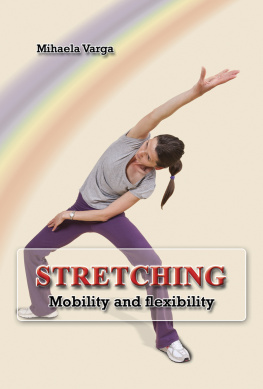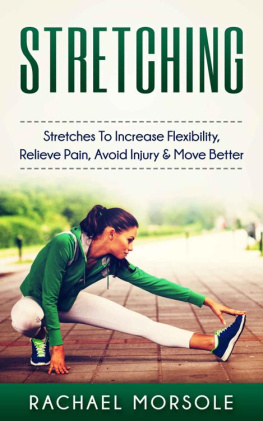THE SCIENCE OF
Stretching

THE SCIENCE OF
Stretching
ALEX REID

THE CROWOOD PRESS

CONTENTS

FOREWORD
Paul Nevin, MSc Performance Coaching, BSc Communications, UEFA Pro Licence, Academy Managers Licence, First Team Coach, Brighton and Hove Albion.
I was fortunate enough to work alongside Alex for a number of years whilst we were at Fulham Football Club around fifteen years ago. Since those days, my career in professional football has taken me around the world and offered many experiences. As a coach who has worked at youth development and senior level, both in the English Premier League and abroad, the beliefs and practices with regards to stretching seem to be an ongoing enigma to the majority of coaches and players.
I have been exposed to numerous different stretching regimes and concepts at different teams and in different environments, varying from static stretching to dynamic stretching, and from ballistic stretching to no stretching at all. With all of these different stretching modalities and philosophies, which are presented as a seemingly logical argument for inclusion and often with data to support a particular approach for the coaching and support staff to consider, the question is, which one should we choose?
Without exploring the research principals behind each different stretching modality, and perhaps considering coach or player preference, the choice for physical preparation may be slightly ambiguous, haphazard and limited because of current knowledge, hard-headedness, the concept of thats what we did and beliefs. Having trust in the sports science and physical preparation team who prescribe the conditioning to the players is important. It is also important to consider that we are dealing with individual athletes at different points in their careers, with different competition needs, different ages and injury histories, as well as differing environments. For example, I am sure that hot or cold climates and extreme temperatures may also play a part in what is necessary for appropriate physical preparation before training or match play and also for recovery and regeneration.

Choosing the appropriate stretching modality has been demonstrated to affect performance variables.
Although football is a team game, the sport itself is increasingly understanding and respecting the need to treat each team member as an individual with regard to their physical and technical development programmes. As science and research progress, and more and more knowledge and answers are sought and found, I believe that an open and possibly fluid approach to stretching in preparing for competition, preventing injury and ensuring optimal recovery from matches and training is important. The desire to stretch in order to improve or to maintain flexibility will continue to be practised in its many guises, but knowing when to do it and the correct modality of choice in order to benefit optimally are important, especially in high-performance sport.
In addition to all the stretching scientific theory, current research, practices and specific applications, which you will find in this book, when it comes to most sports and certainly in professional football, it is important to recognize that players will just be comfortable in doing and repeating what feels good for them, especially if their routine brought them a win and three valuable points in the previous game!

INTRODUCTION: WHY DO WE STRETCH?
I have been involved in sport since I can remember, from running around at primary school with my friends, to playing sport at an elite level, to coaching and training athletes in recent years. Throughout this time, the same questions have arisen: Why do we stretch? What type of stretch should I complete? For how long should I hold the stretch? What are the benefits or am I just wasting my time? There seems to be much confusion and ambiguity regarding the rationale and application of different stretching modalities and even whether we should or should not spend any time on stretching at all.
This book will take on a research-based approach, justifying the rationale as to when, why and if we should stretch, and, if we should stretch, what we can expect to be the outcome. The content will address the physiological principals of stretching and any physiological adaptations that occur as a result of stretching the muscle fibres.
I personally believe that people stretch for a number of reasons, such as its what you do before and after exercise, or its expected preparation by your coach and teammates. But have you considered the different modes of stretching and why one may be more appropriate than another depending on what your outcome targets may be? Why, for instance, would you select dynamic flexibility rather than static stretching before exercise? Does the muscle temperature or body temperature affect the outcome? Is there a psychological benefit of stretching, such as mental preparation before competition or assisting with prematch nerves? Will we pull a muscle if we dont stretch or pull a muscle if we do?
The Science of Stretching will investigate the reasons for stretching and the rationale for which type of stretch to complete. It will aim to guide you towards a positive outcome with your performance and level of function as a result of effective stretching and mobility exercises.
Mobility is defined as the ability to move or be moved freely and easily. This is in essence what the purpose of stretching may be. From the same resource, to stretch is defined as (of something soft or elastic) be made or be capable of being made longer or wider without tearing or breaking. Flexibility is defined as the quality of bending easily without breaking, whereas being extensible allows you to accommodate change. These are all ways to describe a form of movement that prepares the human body for performance and function, and ensures an optimal, effective and safe outcome.

Why do we stretch?
In a performance or during physical demands, mobility and extensibility may be more appropriate descriptions when referring to the human body. We want to move freely and easily, especially when performing physical exertions, like dance and sports, and we want to accommodate change, especially when the movements may challenge the full range of motion that the body can achieve, for example, in gymnastics or in a lunge tackle in football.
In elite sport, effective recovery is essential for day to day high performance, but when I look at athletes stretching it appears to be more of a post-session debrief or chat about the weekend, rather than an important component of their conditioning, recovery and fitness. Does this matter? As practitioners, our role surely has to be to educate the athletes and coaches in best practice. The effectiveness and attention to detail that an individual chooses to adopt with this component of fitness may be important and may affect the outcome of their actions. Or is it irrelevant to the outcome? Does which type of stretch you select affect your performance? Are you just holding your quadriceps stretch with poor form and chatting, or are you actually stretching the muscle fibres, tilting your pelvis to increase the range of motion or movement (ROM) and stretch tolerance, and therefore focusing on a positive physical outcome of that specific stretch?
Next page




















